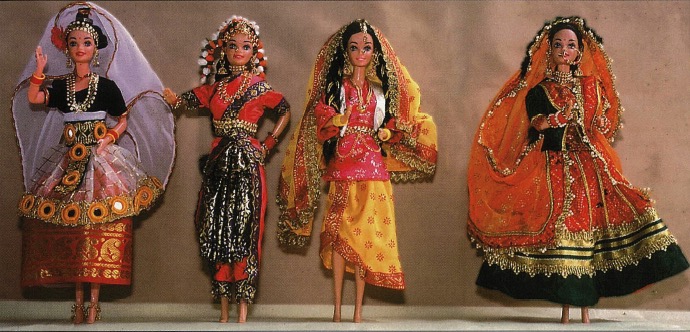A collaborative effort between US toy giant Mattel and the Indian company Leo Toys has resulted in the skillfully executed “Expressions of India” series of “Barbie” dolls. When introduced in 1996, each doll sold for Rs. 600 in India (about us$15). Production ended last year, and now they are hot collector’s items, claiming a premium price in America of $85.00 each–when you can find one.
Barbie, for the non-cognoscenti, is a foot-high plastic doll first introduced by Mattel toys in 1959. They’ve since sold a mind-boggling one billion dolls, making Barbie the best-selling toy of all times. It is plausibly claimed by Mattel that every American girl has owned a Barbie by age eleven.
Even though the dolls are “just a toy,” and intended for five- to eleven-year-old girls, Barbie has become, since her introduction forty years ago, a kind of barometer of American attitudes toward women. For example, Mattel’s decision in late 1997 to modify the doll’s appearance resulted in a front-page article in the Wall Street Journal, and numerous other articles and editorials on the social significance of the changes (such as her less shapely 90s figure).
Barbie is a “fashion doll,” intended to fulfill a child’s fantasies of growing up. She also retains a cult following among adults, one sign of which is that nearly every major clothes designer, such as Oscar de la Renta, has created outfits for Barbie. Among collectors, a very rare Barbie can fetch $1,500.
The “Expressions in India” series is part of a global effort by Mattel begun in 1981 to produce accurate ethnic dolls that successfully transplant Barbie into every race and nation. Originally, Mattel exported Barbie in her native look and dress, that is, blond hair, pink sunglasses, pink mini-skirt, pink bicycle, and tanned, tall and handsome boy-friend, Ken. She found modest success when so introduced to India in 1987, but not Ken (an exact clone of actor Robert Redford, incidentally), who flopped among young Indian girls not used to the idea of having a boy friend. Manufacturers adjusted Barbie to look more Indian, with dark hair, a shade darker skin, bindu, and Indian dress. Initially most of the outfits were saris of various colors, selling for as low as Rs. 109. Only later did they venture into the detailed, hand-made outfits of the “Expressions of India” series.
The “Mystical Manipuri” Barbie comes in the traditional folk dance dress of the Indian state of Manipur. The red skirt is decorated with gold brocade, and the doll loaded with authentic jewelry includes a gold necklace, head dress, gold anklets and red and yellow bangles. The Bharata Natyam doll is named “Swapna Sundari,” which happens to be the name of a famous Kuchipudi dancer. Swapna (the real-life dancer) was miffed by Mattel’s appropriation of her name, and the doll was immediately withdrawn from production.
The Sohni Punjab Di, “Beauty of Punjab,” doll is attired in the style of the state of Punjab, with a satin yellow sarong-like skirt or lungi that has pink/fuchsia flowers and a gold brocade border, a matching kurta blouse and substantial jewelry. The last doll, Roopvati Rajasthani, is of the style of Rajasthan, and is especially elaborate, including an oversize nose ring that would be eight inches in diameter in real life. Mattel has created dolls in the regional dress of Japan, the Philippines, Norway, Ireland, Native Americans and many more nations of the world.
SOURCES: KAY’S COLLECTIBLES, 208 TINDERWOOD DRIVE, FRANKFORT, KENTUCKY, 40601-4004 USA


